
Skáli Hallvarðs Súganda - Viking Settlement-Age Farm in the Westfjords of Iceland

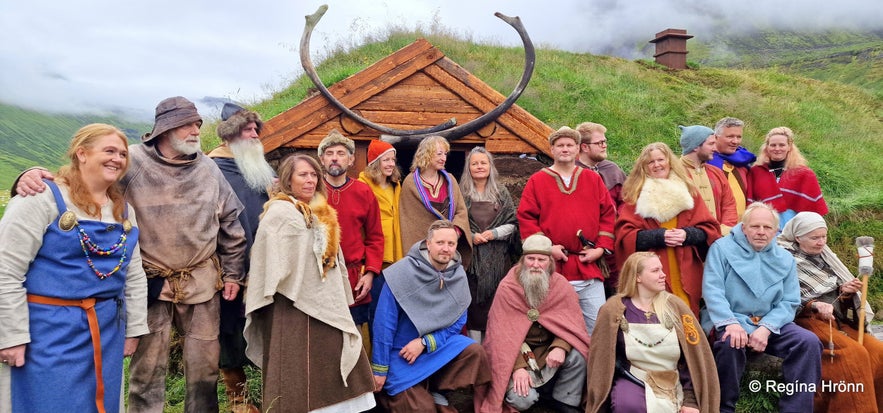
I hit the jackpot when I was invited to attend the opening of Skáli Hallvarðs súganda - a replica of a Viking settlement-age farm, built to honor the legacy of Hallvarður súgandi, the settler of Súgandafjörður in the Westfjords of Iceland.
Opening photo: a group of Vikings all dressed up for the opening ceremony of Skáli Hallvarðs súganda
The making of Skáli Hallvarðs súganda settlement-age farm
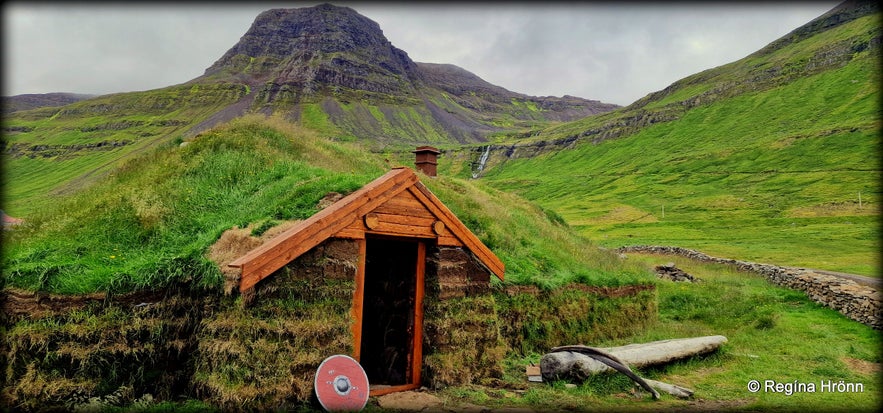
Did Hallvarður súgandi live in this location at Botn and is his burial mound by the mountain?
The local society Fornminjafélag Súgandafjarðar started building the settlement-age farm in the summer of 2018 in Botn in Súgandafjörður bay, and the construction work took 6 years.
The material is mainly local, the driftwood is from Hraun at Skagi though (in North Iceland), the timber is from the Ísafjörður Tunguskógur woodland, and the peat is from the Botnsdalur valley.
And the building methods are traditional, although a few screws and tar paper were used for safety reasons and better maintenance, as these turf houses need constant upkeep.
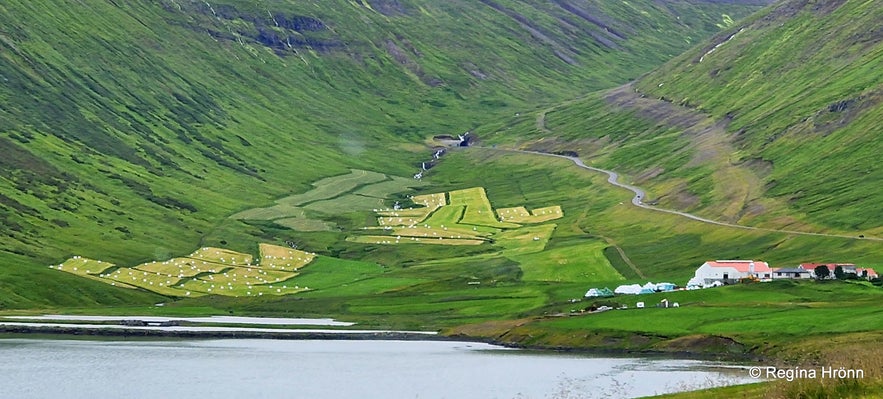 Botnsdalur valley - can you spot Skáli Hallvarðs súganda in this photo?
Botnsdalur valley - can you spot Skáli Hallvarðs súganda in this photo?
It was important for the settlers to build their houses by a bog where they could find enough peat for the building of their houses.
The farmers at Botn farm gracefully donated both the peat from their land for the building of Skáli Hallvarðs súganda, and a strip of their land.
The settlement-age farm of Hallvarður súgandi was built to the liking of the archaeological ruins of a settlement-age farm called Grélutóftir, which were discovered in 1977 by the sea close to Hrafnseyri in Arnarfjörður, and examined in 1977-1978.
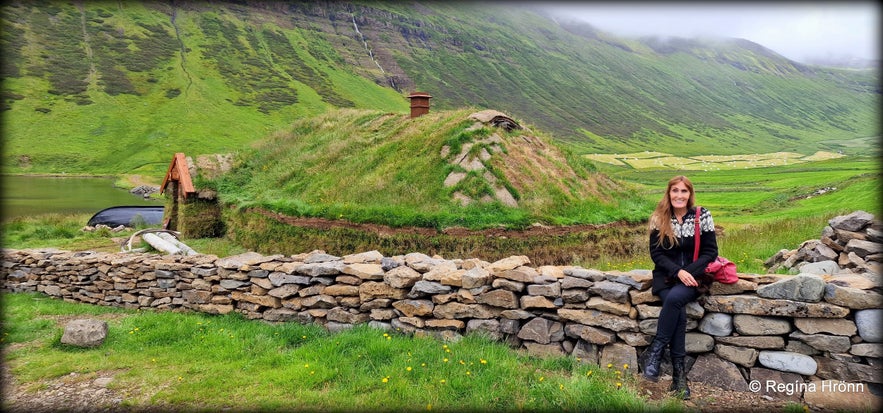
Skáli Hallvarðs Súganda settlement-age farm
So it is as accurate as possible and looks like what we imagine that the settlement-age farms in the Westfjords looked like more than 1100 years ago.
Grélutóftir and Skáli Hallvarðs súganda are 14 meters long and 5 meters wide, and some 6-8 people could live on this settlement-age farm. This was a farm for a normal family, the richer families had bigger farms.
Ruins of the biggest longhouse found in Iceland so far were discovered at Stöð in the Eastfjords, it is 44 meters long!
You can see what other archaeological ruins look like in my article about: Ancient Ruins and Burial Mounds I have visited on my Travels in Iceland.
 Skáli Hallvarðs súganda - Botn farm in the distance
Skáli Hallvarðs súganda - Botn farm in the distance
Skáli Hallvarðs súganda settlement-age farm stands in such a lovely location, be on the lookout for it right after you exit the side tunnel to Súgandafjörður fjord.
Kudos to all those who came up with the idea and helped with the building of Skáli Hallvarðs súganda, for their enthusiasm and hard work - a job well done.
I have written a long article about all the turf houses in Iceland, if you want to see what they look like: A List of the beautiful Icelandic Turf Houses, I have visited on my Travels in Iceland, and I have added Skáli Hallvarðs súganda to that travel-blog.
The opening ceremony of Skáli Hallvarðs súganda in August 2024
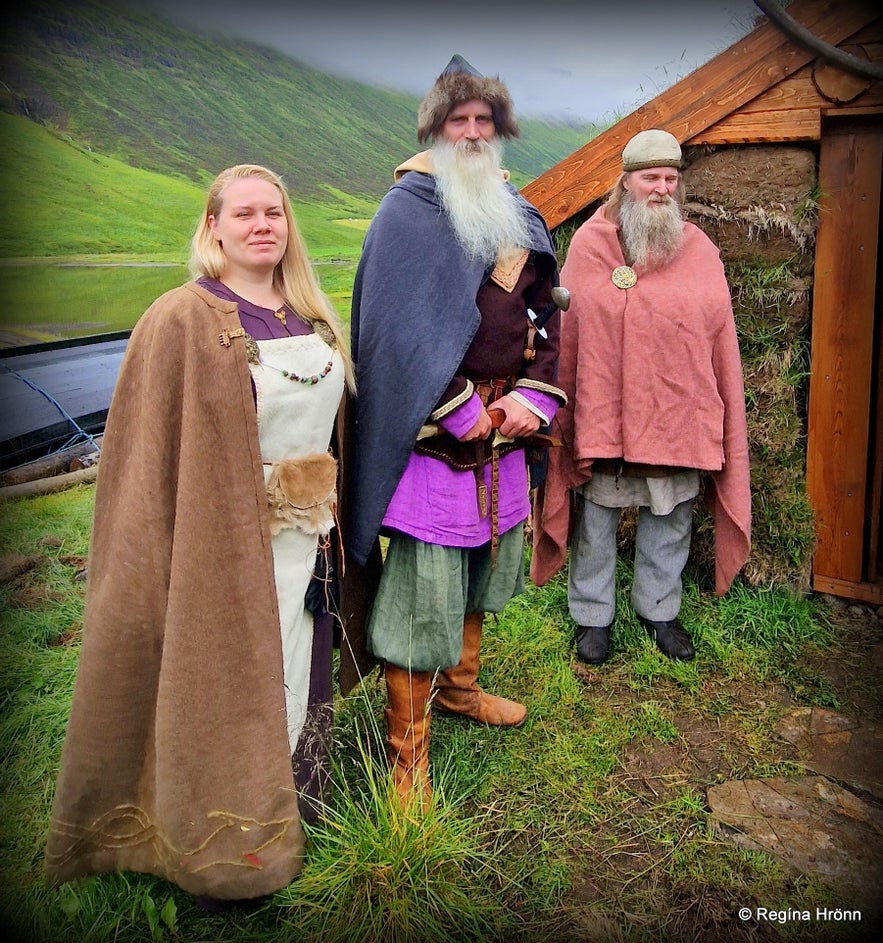 Vikings all dressed up for the opening ceremony
Vikings all dressed up for the opening ceremony
The opening ceremony of the settlement-age farm of the settler Hallvarður súgandi took place on the Archaeological day of the Westfjords, and it was so lovely to be able to attend the opening of this hypothetical farm of the settler of Súgandafjörður.
My husband was performing at the 20th Act Alone festival in Súgandafjörður bay, so he was busy in Suðureyri village, while I was inside Skáli Hallvarðs súganda, which was right up my alley.
The opening ceremony of Skáli Hallvarðs súganda was held inside the settlement-age farm and we, some 90 people who attended, gathered around the longfire in the settlement-age farm and those who couldn't fit inside stood outside.
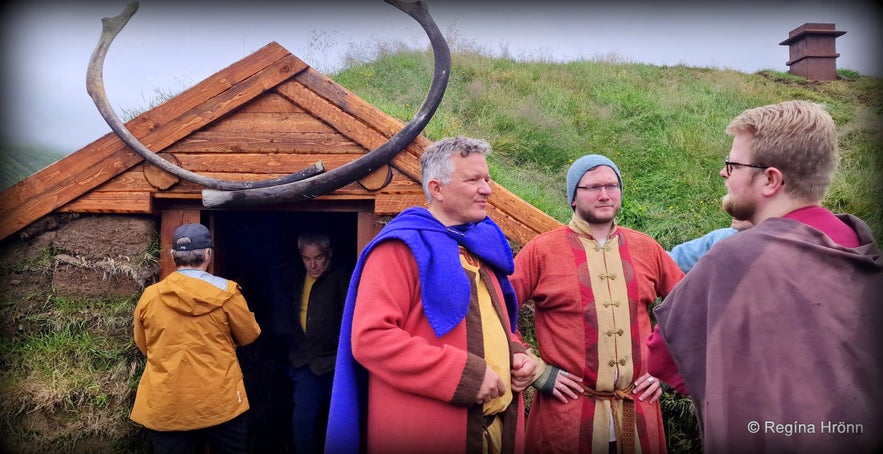
By Skáli Hallvarðs súganda before the opening ceremony started - Eyþór Eðvarðsson in a blue cape
For 2 hours we listened to very informative talks about the story of Hallvarður súgandi, the making of Skáli Hallvarðs súganda, archaeological excavations in the Westfjords, and weaponry in the Viking age.
In the photo below you see Elfar Logi, the Haukadalsgoði Chieftain, telling us about the gruesome killings of the Basques in 1615.
Elfar Logi is the one who invited us to Súgandafjörður.
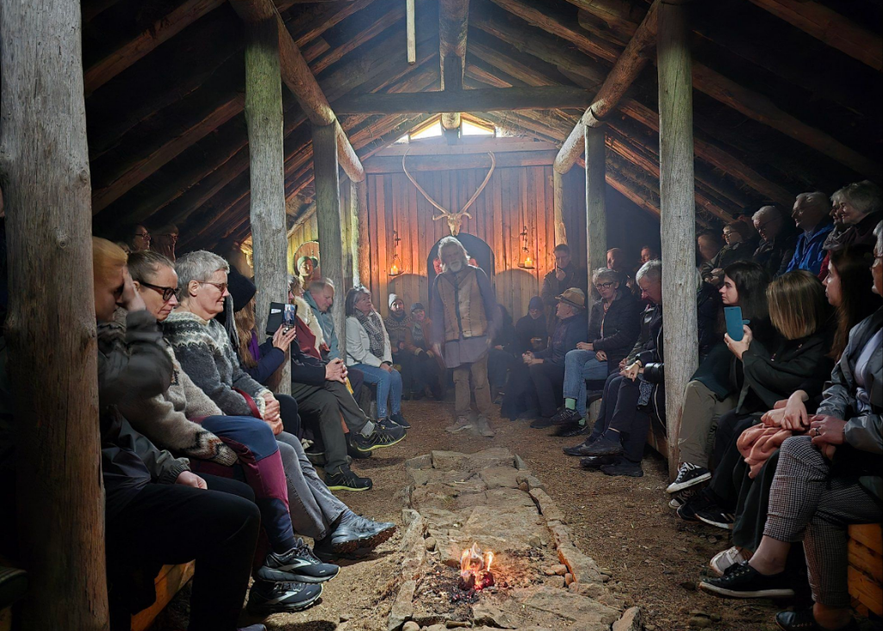
In the photo above you can also see me on the left-hand side holding up my phone trying to take a decent photo, but in vain, so I was gracefully allowed to use Ingrid Kuhlman's photo.
I can tell you that I felt very close to my Icelandic roots while attending the opening of Skáli Hallvarðs súganda and I think that I was not the only one. My ancestors lived in the Westfjords for some 400 years, and I have strong ties to this part of Iceland.
It was a soulful moment and we could feel the spirit of our ancestors who fled from Norway and settled on a cold island way up north. And made themselves a home on a settlement-age farm like this one.
And let's not forget the Irish, who also lived here in Iceland. We know so little about them, but they are also our ancestors.
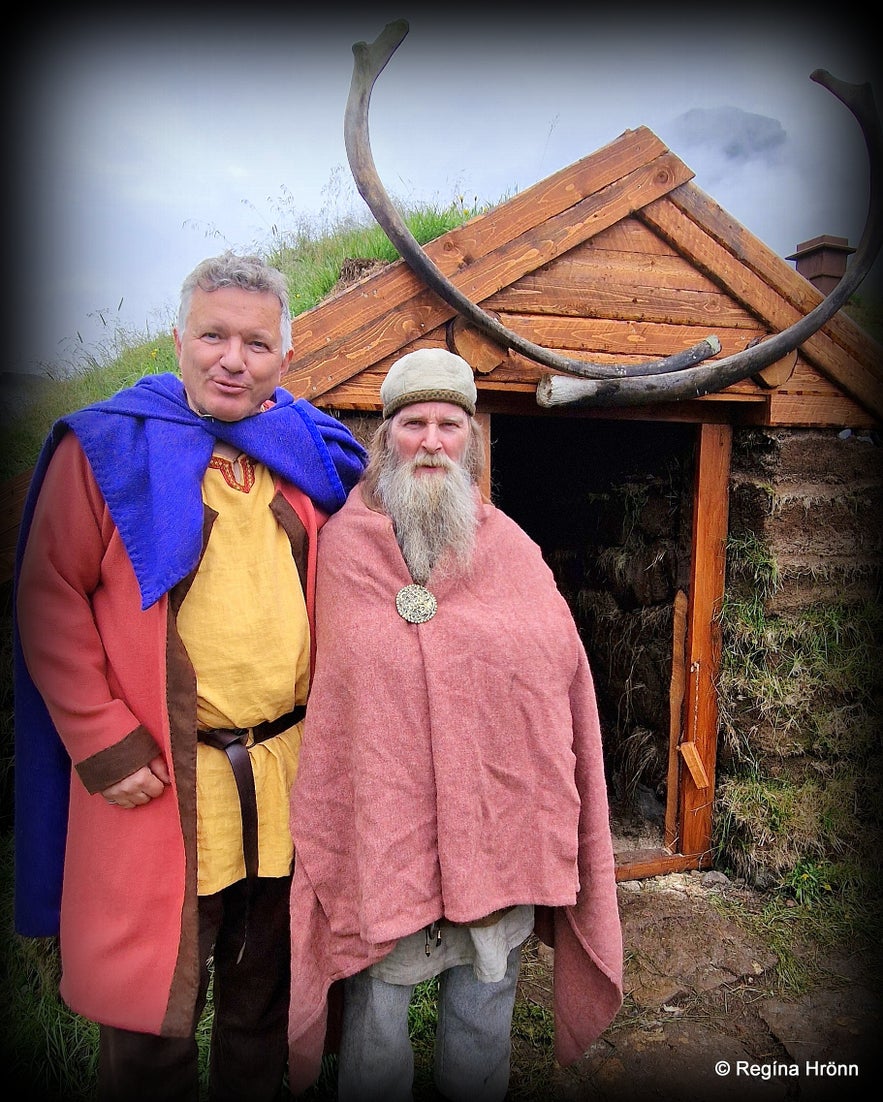 Eyþór Eðvarðsson all dressed up for the ceremony
Eyþór Eðvarðsson all dressed up for the ceremony
Eyþór Eðvarðsson, to the left in my photo above, was instrumental in building the settlement-age farm of the settler Hallvarður súgandi.
I add links at the end of this article to TV interviews with Eyþór on-site in which you can follow the making of Skáli Hallvarðs súganda.
Of course, this was not a one-man job, and Eyþór told me that around 60 people helped with the building of the Viking longhouse one way or another, most of them volunteers. Thank you for all your hard work - now look at how beautiful the Skáli Hallvarðs súganda settlement-age farm is :)
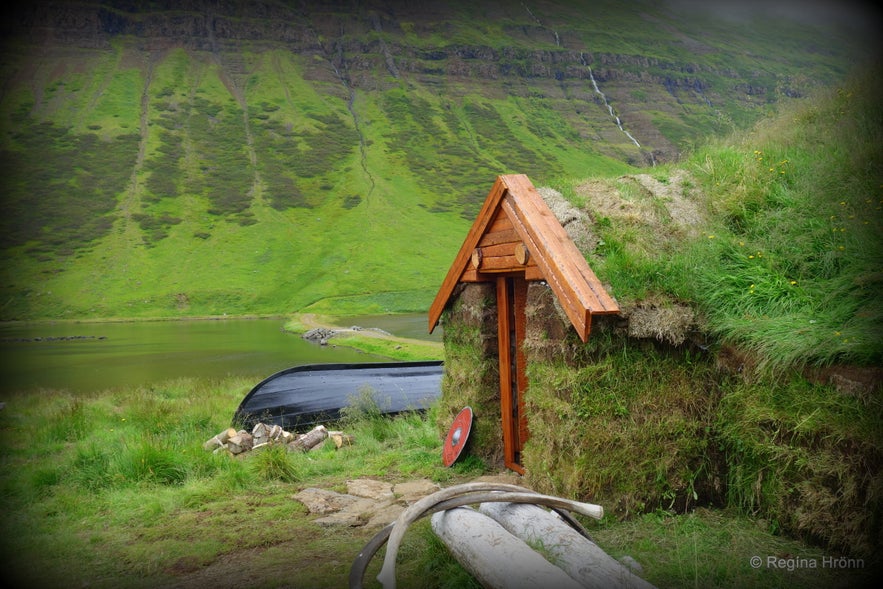
Skáli Hallvarðs súganda
I didn't visit the Grélutóftir archaeological site to see what the archaeological area looked like, even though I very much wanted to see it.
Mainly because it is in a closed-off area where the Arctic tern is nesting (and they will fiercely attack you). I will try again later after the Arctic tern leaves Iceland.
In the photo below is Margrét, who is an archaeologist in this part of the Westfjords, and she is in charge of the Grélutóftir archaeological site, as well as the archaeological sites at Hrafnseyri and Auðkúla.

With Margrét inside Skáli Hallvarðs súganda the day before the opening ceremony
Margrét is one of the many people who assisted with the making of the Skáli Hallvarðs súganda settlement-age farm.
I first visited the settlement-age farm the day before the opening, to take some photos, but was invited into the longhouse, where Margrét and Eyþór along with others were making the final arrangements for the opening on the following day.
The longfire in the middle of the settlement-age farm was carefully made by 4 archaeologists and we stayed for the testing of the longfire. Was the ventilation good enough?
The longfire was burning during the opening ceremony when Skáli Hallvarðs súganda was filled with people, and the idea was not to suffocate them. The ventilation was perfect, no problem there.
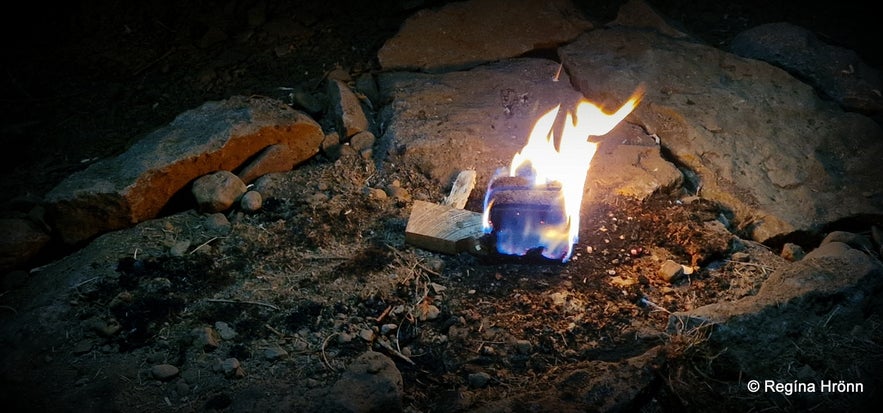 The longfire in Skáli Hallvarðs súganda
The longfire in Skáli Hallvarðs súganda
Margrét was kind enough to allow us to visit the archaeological site at Auðkúla. There were no Arctic terns there.
In my photo below you can see the remains of the Viking settlement-age farm at Auðkúla. I am pointing towards the longfire in the longhouse.
You can only visit it with permission as these archaeological sites are very delicate and the archaeologists are still working there finding more and more stuff that puts new light on the settlement-age of Iceland.

The settlement-age farm at Auðkúla archaeological site
At Auðkúla pithouses and seaweed-burning houses have been found, but seaweed-burning houses have only been found in 2 locations in Iceland, at Auðkúla and Grélutóftir archaeological sites. We believe that the seaweed was burnt to make salt.
Who was Hallvarður súgandi?
 The surroundings by Skáli Hallvarðs súganda are ever so beautiful
The surroundings by Skáli Hallvarðs súganda are ever so beautiful
Now, who was this Hallvarður súgandi and what do we know about him?
Very little in fact, but the sources that we do have are Landnámabók - the Book of Settlements and he is also mentioned in Grettissaga - the Saga of Grettir the Strong as he accompanied the great-grandfather of Grettir the Strong on Viking raids.
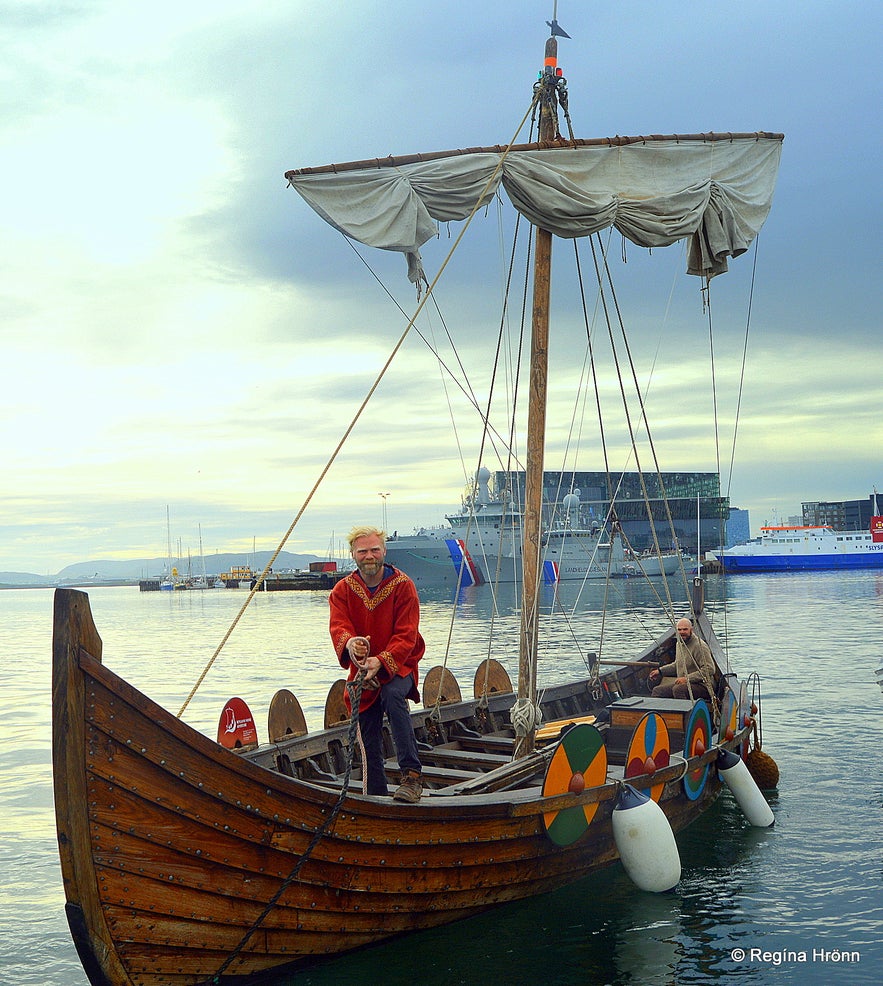 I sailed on this Viking ship from Þingeyri in the Westfjords, when it sailed from Reykjavík harbour
I sailed on this Viking ship from Þingeyri in the Westfjords, when it sailed from Reykjavík harbour
The source from the Saga of Grettir the Strong:
What the Saga of Grettir the Strong tells us in the first chapters of the Saga, and I am recapitulating here, is that Hallvarður was 1 of 4 Norwegian Vikings who had 5 ships between them.
They were the great Viking Önundur Ófeigsson (the great-grandfather of Grettir the Strong), Bálki Blængsson, and Ormur hinn auðgi.
They attacked the Hebrides and King Kjarvalur, which ended in the king's retreat. They attacked Ireland and Scotland for 3 years and returned to Norway with the booty and ships they had plundered.
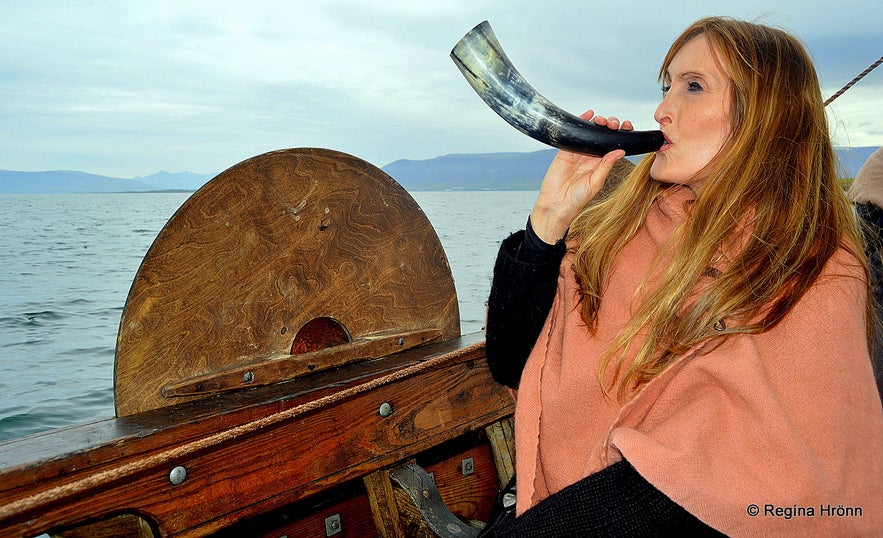 Blowing the horn on a Viking ship from the Westfjords
Blowing the horn on a Viking ship from the Westfjords
By now King Harald Fairhair (Haraldur hárfagri) was taking over Norway with force and Önundur and his companions, upon arriving in Norway, ended up in a battle with the king.
The battle took place in Hafursfjörður bay, and it is believed that this biggest battle of Norway happened on the 18th of July 872.
In the Hafursfjarðarorrustan battle, King Harald battled with 4 other kings and won, thus becoming the king of the entire Norway. After Harald's victory, many Norwegians left Norway and settled in Iceland.
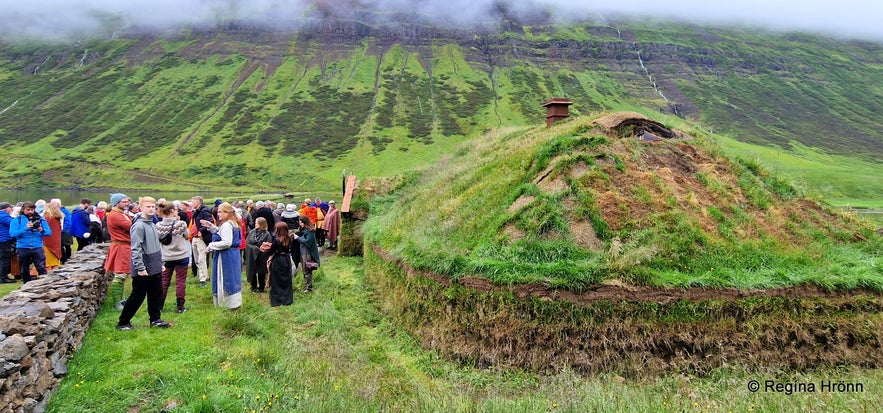
We believe that Hallvarður súgandi settled at Botn in Súgandafjörður upon arriving in Iceland
In this battle, Önundur lost one of his legs below the knee and was from then on called Önundur tréfótur - wooden leg.
Önundur lost many of his men, but he, Hallvarður súgandi, and Bálki, fled the battle with Þrándur Bjarnarson and sailed west, and the Saga tells us about their adventures.
The next summer Hallvarður and Bálki sailed for Iceland, as they had been told that the land was fertile and good. Bálki settled in Hrútafjörður bay and Hallvarður settled in Súgandafjörður and Skálavík as far as Stigar and lived there.
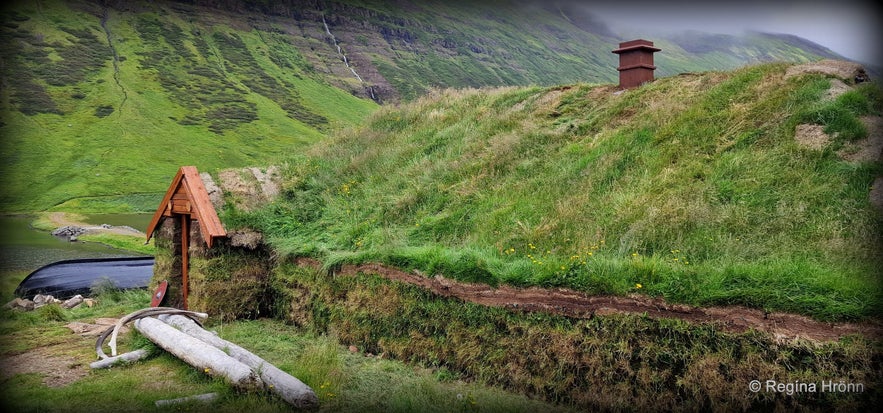
Our source from Landnáma - the Book of Settlements:
Landnáma (Sturlubók) tells us in the 50th chapter that Hallvarður súgandi went to a battle against King Harald of Norway in Hafursfjörður bay.
Hallvarður left that battle and sailed to Iceland and settled the Súgandafjörður bay and Skálavík cove (the next cove to Súgandafjörður) to Stigar and lived there.
The nickname "súgandi" means thunderous and can refer to the thunderous sea in Súgandafjörður bay. So the bay is either named after Hallvarður súgandi or he got the nickname from the fjord itself.
If you read the Icelandic Sagas you will notice that many of the settlers had a nickname, which is convenient for us when reading the Sagas when many of them bear the same name.
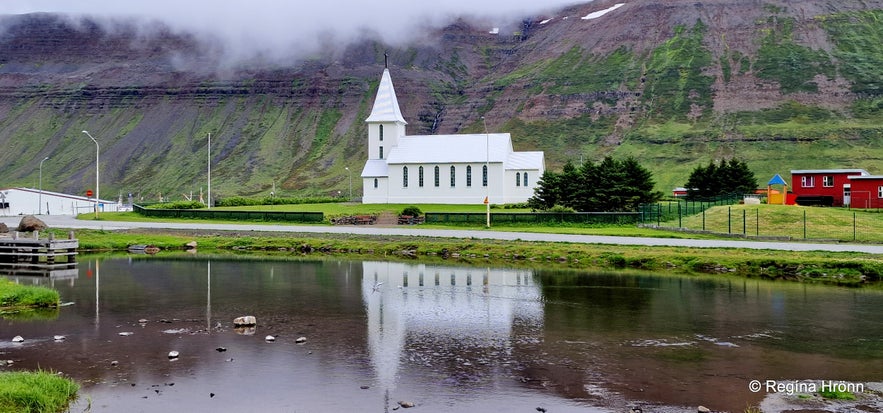 Suðureyri village by Súgandafjörður fjord
Suðureyri village by Súgandafjörður fjord
Hallvarður is mentioned again in Landnáma (Sturlubók) when Helgi Hrólfsson sailed to Iceland to meet his kinsmen.
He arrived at Eyjafjörður, but it was fully settled. So he meant to leave Iceland, but due to bad weather, his ship somehow drifted to Súgandafjörður.
Helgi stayed with Hallvarður for the winter and the next spring he found a harpoon in a fjord. He called the fjord Skutilsfjörður - Harpoon Fjord.

Ísafjörður town stands by Skutulsfjörður fjord
Those of you who have visited the Westfjords will for sure know where that fjord is as Ísafjörður town stands by this fjord. So the settler of the biggest town in the Westfjords stayed with Hallvarður súgandi for the winter.
Landnáma (Hauksbók) also mentions that Hallvarður came from Hordaland in Norway from Sætur (Sætrum).

But Eyþór told us at the opening ceremony that the Norwegians had told him that there is no Sætur in Hordaland, but in another place in Norway, from which Hallvarður súgandi came.
And in that area, the Norwegian language is similar to the Icelandic language.
So this is what we know about Hallvarður súgandi - maybe he had a Saga of his own, which is now lost, who knows, many of the Sagas were lost and we are very grateful for the ones that survived (some 42 Sagas plus some later Sagas ).
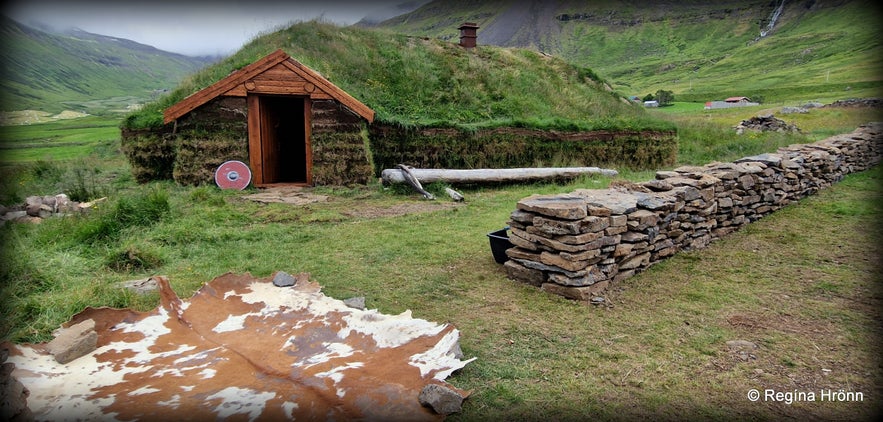 Skáli Hallvarðs súganda
Skáli Hallvarðs súganda
Skáli Hallvarðs súganda is open to visitors free of charge. Let's treat it with respect, and leave nothing behind but our footsteps, and always lock the door behind you after your visit.
Somebody lit a fire inside Skáli Hallvarðs súganda, so rules were made for visiting it. Sheep Trail Adventures made a poster for Eyþór with rules and they were kind enough to allow me to publish the rules in my travel-blog:
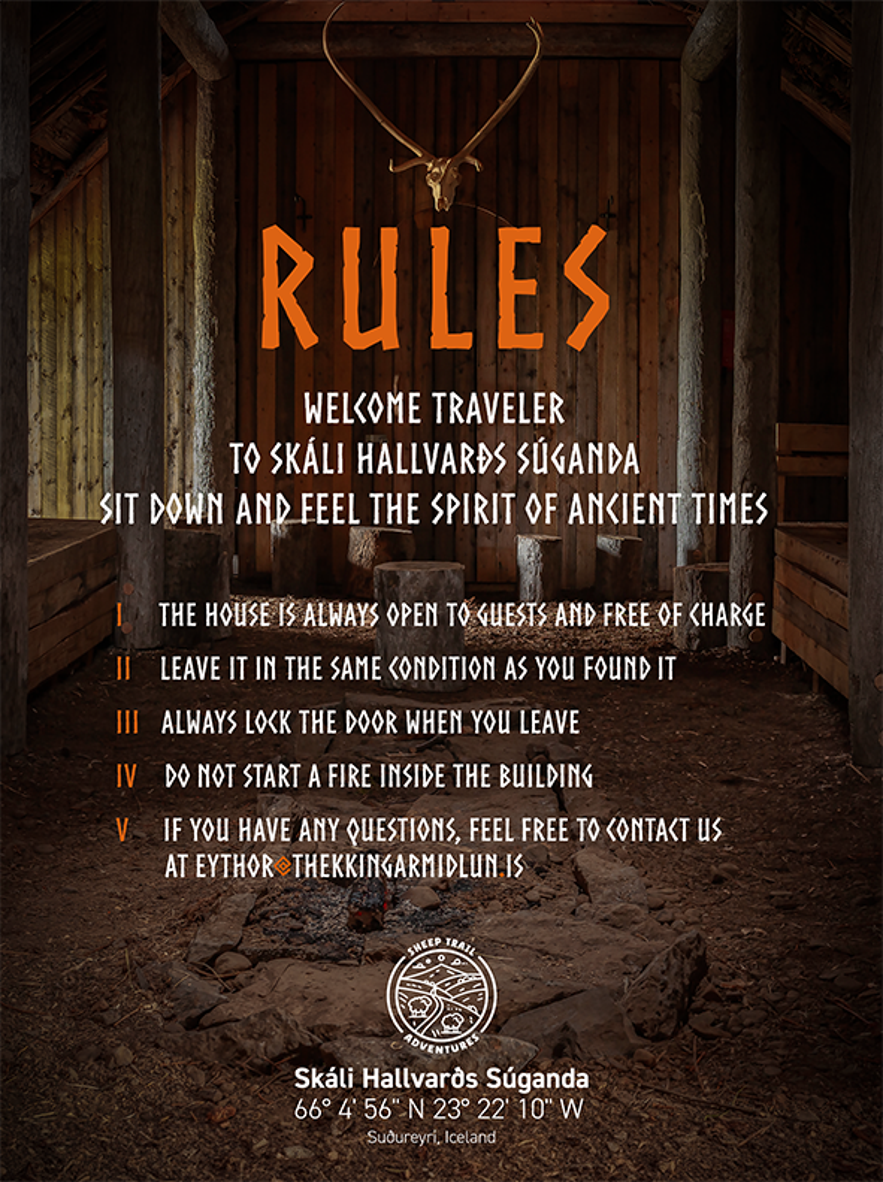
It is well worth visiting the valleys and remote fjords of Iceland, we always do so and have found many a gem hidden away in remote places.
And, if you know the history of the valleys and fjords before you visit them, then it will enrich your visit and you will know what to look for.
I have had to revisit a remote place as I f.ex. missed a particular very important rock or a burial mound that I hadn't known about on my first visit.
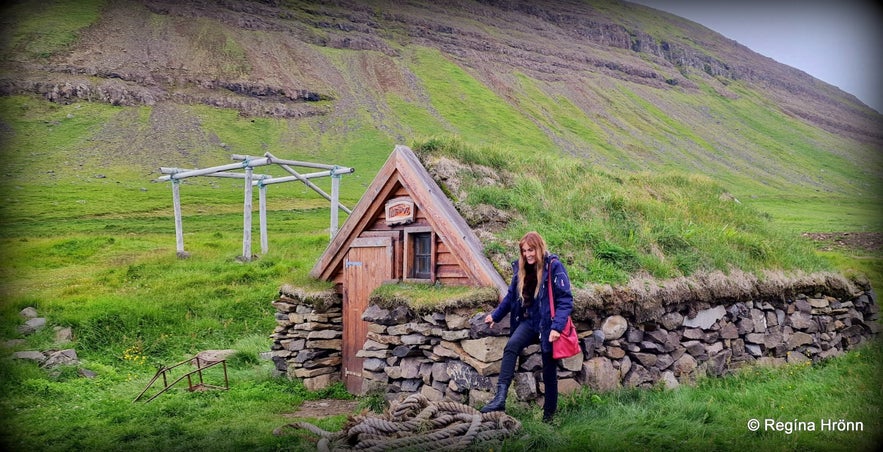 I found this replica of a fisherman's cottage in Staðardalur valley
I found this replica of a fisherman's cottage in Staðardalur valley
As I told you earlier then I have written a long article about burial mounds and archaeological sites in Iceland that I have visited during my travels around my country, and am always updating it when I visit a "new" site: Ancient Ruins and Burial Mounds I have visited on my Travels in Iceland.
I am just a layman though, who loves the Icelandic Sagas and I look for the places where the Sagas took place on my travels around my country.
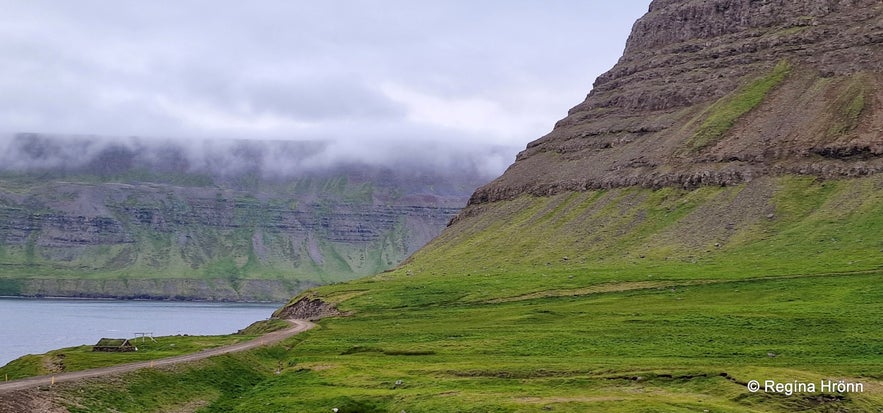 Súgandafjörður, notice the fisherman's cottage with a turf roof to the left in this photo
Súgandafjörður, notice the fisherman's cottage with a turf roof to the left in this photo
If you drive to the end of the road 65 and pass Suðureyri village in Súgandafjörður, you will find 2 farms, Staður and Bær, and the lovely little Staðarkirkja church in Staðardalur valley.
We visit all the farm churches in Iceland, of which there are many, and sometimes drive for long distances into valleys to find a church.
 Mugison held a concert in Staðarkirkja church in Súgandafjörður
Mugison held a concert in Staðarkirkja church in Súgandafjörður
On this occasion, many people were driving to Staðarkirkja church as a famous Icelandic artist, Mugison, held a concert in the church during our visit to Súgandafjörður.
The church was full and people were standing outside listening to the concert.
Mugison was on a tour of 100 churches in Iceland in which he was planning to have a concert. A couple of days later we joined him to another Staðarkirkja church in Aðalvík in the Hornstrandir region, which can only be reached by boat.
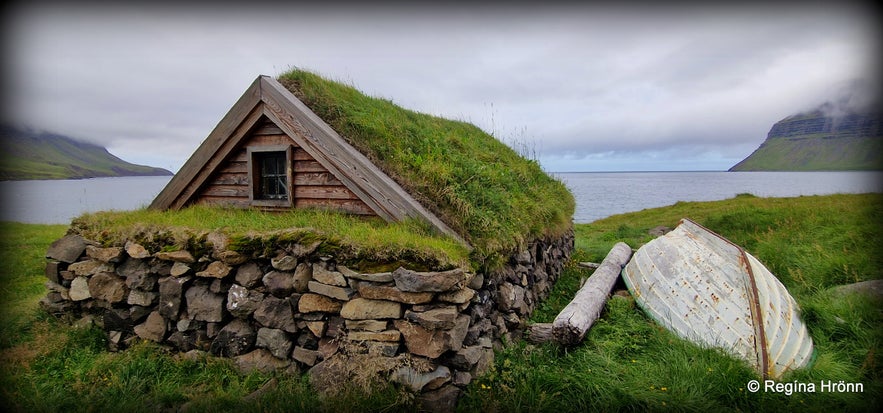 The fisherman's shed Ársól in Súgandafjörður bay
The fisherman's shed Ársól in Súgandafjörður bay
On the way to Staðardalur valley, by the sea at Hreggnasi by Keravík cove, you will see this little fisherman's shed, called Ársól. It was named after the women's club Ársól.
It was also built by Fornminjafélag Súgandafjarðar like Skáli Hallvarðs súganda to the liking of a 1000-year-old fisherman's shed. In this area, many remains of old fishermen's sheds were discovered.
Ársól was built by volunteers and the construction work started in 2016 and finished a year later.
Also, in Staðardalur valley, a large Viking longhouse is being built. We got permission to enter it and it will be interesting to revisit it when it is finished.
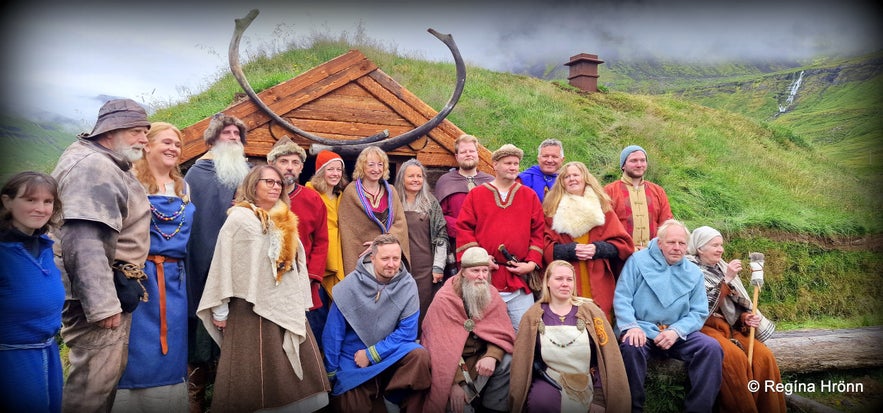
I took a myriad of photos of the Vikings outside the Skáli Hallvarðs súganda settlement-age farm
I love Vestfirðingar - the people of the Westfjords, who live here in this rugged and remote area of Iceland.
I am 1/4th Vestfirðingur as my grandmother was born at Sæból in Ingjaldssandur in the next fjord to Súgandafjörður, as I have shown you in another travel-blog: Sæból at Ingjaldssandur in the Westfjords of Iceland - my Grandmother's Birthplace.
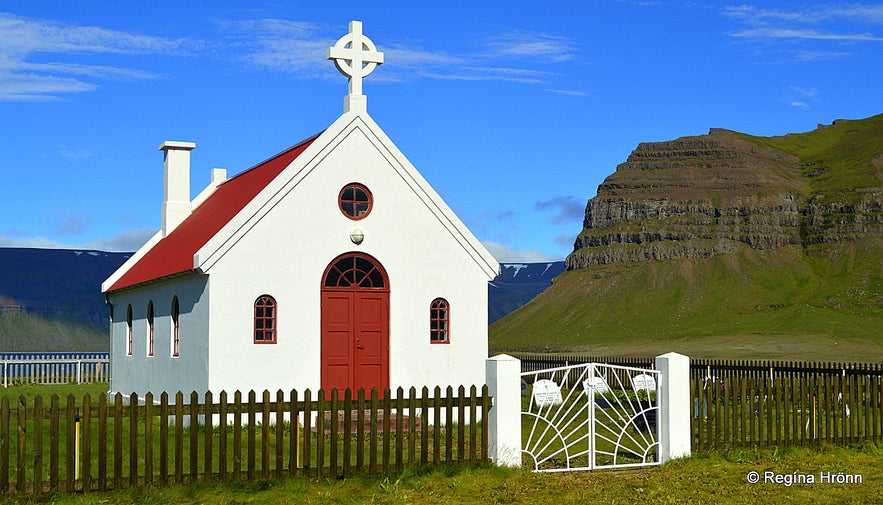 Ingjaldssandur is in the next fjord to Súgandafjörður - there you will find Sæbólskirkja church
Ingjaldssandur is in the next fjord to Súgandafjörður - there you will find Sæbólskirkja church
Here on Breiðadalsheiði heath through which the tunnel now cuts, my great-great-grandmother, Sigríður Mailína, froze to death in April 1908, when she meant to accompany the postman from Ísafjörður to Selakirkjuból in Önundarfjörður on the other side of the heath bearing some good tidings.
I always think about her when we drive through the tunnel and how times have changed for the better. One has got to cherish the tunnels in the Westfjords.
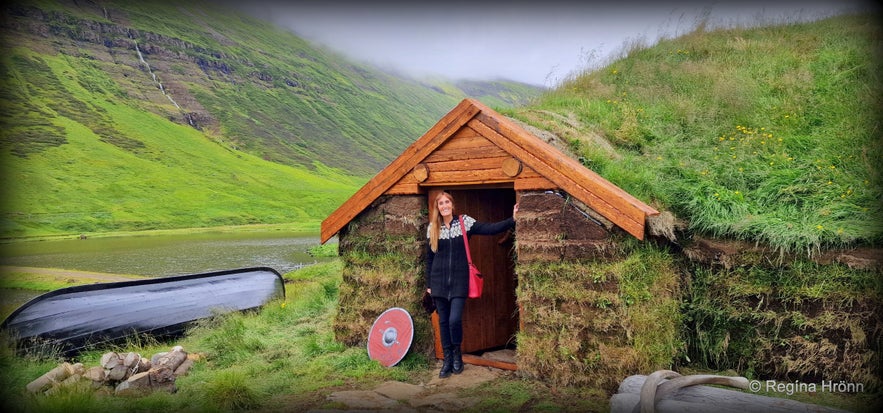 Don't miss stopping by Súgandafjörður fjord and visit Skáli Hallvarðs súganda settlement-age farm when driving in the Westfjords of Iceland.
Don't miss stopping by Súgandafjörður fjord and visit Skáli Hallvarðs súganda settlement-age farm when driving in the Westfjords of Iceland.
If you are coming from Ísafjörður town take a right turn in the tunnel, which will take you via a side tunnel into this beautiful area.
Have a lovely time in the beautiful Westfjords of Iceland. I have written a myriad of other articles about the Westfjords, as I love this part of Iceland :)
Ref:
Landinn - reisa landnámsskála fyrir Hallvarð súganda (the making of Skáli Hallvarðs súganda)
Landnámsskáli í Súgandafirði til heiðurs íslenskri sagnahefð
Eins vestfirskur skáli og hægt er
Fornleifar á Vestfjörðum. Grélutóftir við Hrafnseyri
Landnáma - Sturlubók and Hauksbók
Otros blogs interesantes
Chasing Waterfalls in Iceland
Iceland is spectacular in so many ways and Icelandic nature is quite unique with its vast landscape, volcanic activity, geothermal areas, glacier lagoons and sceneries, black sand beaches and spectLeer másSænautasel Turf House in the Highland of Iceland
In my search for turf houses around Iceland, I visited Sænautasel, which is a rebuilt turf house on Jökuldalsheiði heath in the highland of Iceland. It is, in my opinion, an extremely cute turf hoLeer másThe Dynamic Plant Lupine
People have been asking me where to find lupines in Iceland. If you like them you should be able to find them easily in Iceland in summer. They are in bloom and visible almost wherever you drive aroLeer más

Descarga la mayor plataforma de viajes a Islandia en tu móvil para gestionar tu viaje al completo desde un solo sitio
Escanea este código QR con la cámara de tu móvil y pulsa en el enlace que aparece para añadir la mayor plataforma de viajes a Islandia a tu bolsillo. Indica tu número de teléfono o dirección de correo electrónico para recibir un SMS o correo electrónico con el enlace de descarga.















